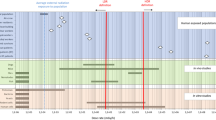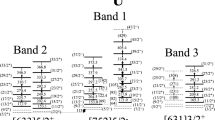Abstract
The induction of resistance to 6-thioguanine by heavy ion exposure was investigated with various accelerated ions (oxygen-uranium) up to linear energy transfer (LET) values of about 15000 keV/µm.31 y Survival curves are exponential with fluence; mutation induction shows a linear dependence. Cross-sections (δi: inactivation, δm: mutation) were derived from the respective slopes. Generally, δi rises over the whole LET range, but separateas into different declining curves for single ions with LET values above 200 keV/µm. Similar behaviour is seen for δm. The new SIS facility at GSI, Darmstadt, makes it possible to study the effects of ions with the same LET but very different energies and track structures. Experiments using nickel and oxygen ions (up to 400 MeV/u) showed that inactivation cross-sections do not depend very much on track structure, i.e. similar values are found with different ions at the same LET. This is not the case for mutation induction, where very energetic ions display considerably smaller induction cross-sections compared with low-energy ions of identical LET. Preliminary analyses using the polymerase chain reaction (PCR) demonstrate that even heavy ions cause “small alterations” (small deletions or base changes). The proportion of the total deletions seems to increase with LET.
Similar content being viewed by others
References
Blakely EA (1992) Cell inactivation by heavy charged particles. Radiat Environ Biophys 31:181–196
Blakely EA, Ngo FQH, Curtis SB, Tobias CA (1984) Heavy-ion radiobiology: cellular studies, In: Lett T (ed) Advances in radiation biology, vol 11. Academic Press, New York, pp 295–389
Castro JR, Saunders WM, Tobias CA, Chen GTY, Curtis S, Lyman JT, Collier JM, Pitluck S, Woodruff KA, Blakely EA, Tenforde T, Char D, Phillips TL, Alpen EL (1983) Treatment of cancer with heavy charged particles. Int J Oncol Biol Phys 8:2191–2198
Cox R, Masson WK (1979) Mutation and inactivation of cultured mammalian cells exposed to beams of accelerated heavy ions. III. Human diploid fibroblasts. Int J Radiat Biol 36:149–160
Heinrich W, Wiegel B, Kraft G (1991) Tables of de/dx range and restricted energy loss of heavy ions in the energy range from 1 to 3000 mev/u. (Technical report, GSI-Report 91-30) GSI, Darmstadt
Hubert F, Bimbot R, Gauvin H (1990) Range and stopping power tables for 2.5–500 mev/u, heavy ions in solids. Atomic and Nuclear Data Tables 46:1–215
Katz R, Dunn DE, Sinclair GI (1985) Thindown in radiobiology. Radiat Prot Dosim 13:281–284
Kiefer J (1985) Review: cellular and subcellular effects of very heavy ions. Int J Radiat Biol 48:873–892
Kiefer J, Straaten H (1986) A model of ion track structure based on classical collisions dynamics. Phys Med Biol 31:1201–1209
Köberle B, Haupter S, Just W, Speit G (1991) Mutation screening of bleomycin-induced V79 Chinese hamster hprt mutants using multiplex polymerase chain reaction. Mutagenesis 6:527–531
Kraft G (1987) Radiobiological effects of very heavy ions: inactivation, induction of chromosome aberrations and strand breaks. Nuel Sci Appl 3:1–28
Kranert T, Schneider E, Kiefer J (1990) Mutation induction in V79 Chinese hamster cells by very heavy ions. Int J Radiat Biol 58:975–987
Kronenberg A, Little JB (1989) Locus specificity for mutation induction in human cells exposed to accelerated heavy ions. Int J Radiat Biol 55:913–924
National Council on Radiation Protection and Measurement (1989) Guidance on radiation received in space activities. (NCRP-report no. 98) NCRP, Bethesda
Rossiter BJF, Fuscoe JC, Muzny DM, Fox M, Caskey CT (1991) The hamster hprt gene: restriction map, sequence analysis, and multiplex PCR deletion screening. Genomics 9:247–256
Stoll U, Röscheisen C, Kiefer J (1993) Multiplex pcr-screening of mutations induced in V79 hamster cells after exposure to deuterium ions. GSI Scientific Report 1992, p 328
Stoll U, Helbig R, Schmidt P, Schneider E, Kiefer J (1994) Mutation induction by heavy ions: cross-sections and molecular analysis. GSI Scientific Report 1993 (in press)
Thacker J, Stretch A, Stephens MA (1979) Mutations and inactivation of cultured mammalian cells exposed to beams of accelerated heavy ions. II. Chinese hamster V79 cells. Int J Radiat Biol 36:137–148
Tsuboi K, Yang TC, Chen DJ (1992) Charged-particle mutagenesis. I. Cytotoxic and mutagenic effects of high-LET charged iron particles on human skin fibroblasts. Radiat Res 129:171–176
Wulf H, Kraft-Weyrather W, Miltenburger HG, Blakely EA, Tobias CA, Kraft G (1985) Heavy-ion effects on mammalian cells: inactivation measurements with different cell lines. Radiat Res 104:S122-S134
Xu Z, Yu Y, Gibbs RA, Caskey CT, Hsie AW (1993) Multiplex DNA amplification and solid-phase sequencing for mutation analysis at the hprt locus in Chinese hamster cells. Mutat Res 288:237–248
Zhang LH, Vrieling H, Van Zeeland AA, Jenssen D (1992) Spectrum of spontaneously occurring mutations in the hprt gene of V79 Chinese hamster cells. J Mol Biol 223:627–635
Author information
Authors and Affiliations
Rights and permissions
About this article
Cite this article
Stoll, U., Schneider, E., Kranert, T. et al. Induction of HPRT- mutants in Chinese hamster V79 cells after heavy ion exposure. Radiat Environ Biophys 34, 91–94 (1995). https://doi.org/10.1007/BF01275212
Received:
Accepted:
Issue Date:
DOI: https://doi.org/10.1007/BF01275212




